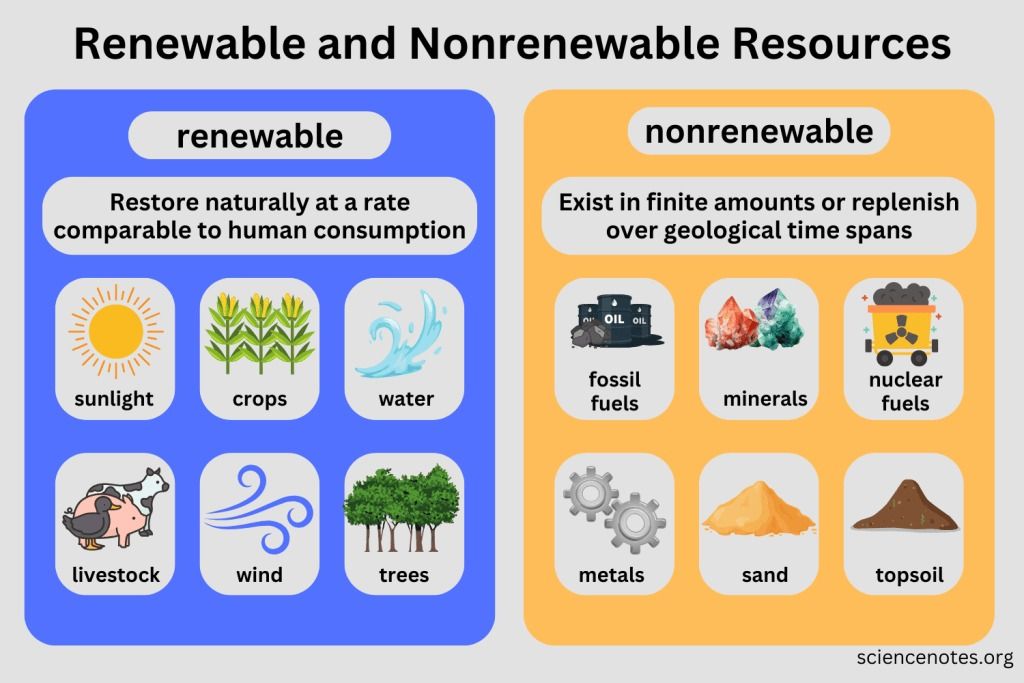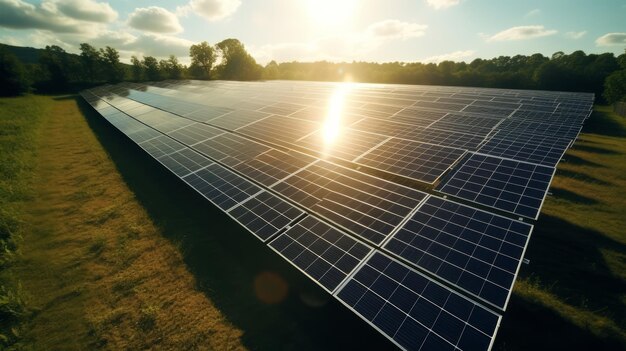
Renewable vs. Non-Renewable Resources: A Full Overview for a Sustainable Future
Imagine a world where the power never runs out, where the air is always clean, and our energy sources don’t harm the planet. Sounds like a dream, right? This dream is at the heart of the global conversation about renewable and non-renewable resources. Understanding the difference between these two fundamental types of resources is not just for scientists or policymakers; it’s crucial for every one of us, as it directly impacts our future, our environment, and our daily lives.
In this comprehensive guide, we’ll break down everything you need to know about renewable and non-renewable resources. We’ll explore what they are, where they come from, their advantages and disadvantages, and why choosing wisely matters more than ever.
What Are Natural Resources? A Simple Start
Before we dive into the "renewable" and "non-renewable" debate, let’s clarify what we mean by natural resources. Simply put, natural resources are all the "stuff" we get from the Earth that we use to live, work, and thrive. This includes everything from the air we breathe and the water we drink, to the materials we use to build homes and the energy that powers our cities.
These resources are essential for human survival and development. But not all resources are created equal when it comes to how long they last or how quickly they can be replaced. This brings us to our main topic.
Part 1: Non-Renewable Resources – The Finite Store
Let’s start with the resources that have a limited supply, like items in a piggy bank that can only be emptied once.
What Are Non-Renewable Resources?
Non-renewable resources are natural resources that exist in finite (limited) amounts and cannot be replenished or recreated by natural processes on a human timescale. This means that once we use them up, they’re gone for good, or at least for millions of years. Their formation takes geological processes that span eons, far longer than a human lifetime or even many generations.
Think of it like a treasure chest filled with gold coins. Once you take all the coins, there are no more, and it takes an incredibly long time (if ever) for new ones to appear.
Key Characteristics of Non-Renewable Resources:
- Finite Supply: There’s a limited amount available on Earth.
- Slow Formation: They take millions of years to form naturally.
- Depletable: They can be used up faster than they can be replaced.
- High Energy Density: Often provide a lot of energy from a small amount of material.
Main Types of Non-Renewable Resources:
The most common non-renewable resources are the ones we rely on heavily for energy today:
1. Fossil Fuels
These are by far the most widely used non-renewable resources for energy production. They were formed over millions of years from the buried remains of ancient plants and animals under intense heat and pressure. When burned, they release stored energy.
-
Coal:
- What it is: A black or brownish-black sedimentary rock composed primarily of carbon.
- How it forms: From ancient peat bogs and swamps, compressed over millions of years.
- Uses: Primarily for electricity generation (burning in power plants), steel production, and cement manufacturing.
- Pros (from a historical perspective): Abundant in many parts of the world, relatively cheap to extract and transport, provides a stable and reliable base load for electricity.
- Cons: Highly polluting (releases large amounts of carbon dioxide (CO2), sulfur dioxide, nitrogen oxides, and particulate matter when burned), contributes significantly to climate change, acid rain, and air pollution. Mining can cause significant environmental damage (e.g., mountaintop removal).
-
Oil (Petroleum):
- What it is: A viscous (thick) liquid, often black or dark brown, found in underground reservoirs.
- How it forms: From the remains of ancient marine organisms, buried and subjected to heat and pressure.
- Uses: Fuel for transportation (gasoline, diesel, jet fuel), heating oil, raw material for plastics, chemicals, and pharmaceuticals (petrochemicals).
- Pros: High energy density, relatively easy to transport, forms the backbone of modern transportation.
- Cons: Releases CO2 when burned, contributes to climate change, prone to spills during extraction and transport (causing massive environmental damage), geopolitical instability due to uneven distribution.
-
Natural Gas:
- What it is: A flammable gaseous mixture of hydrocarbons, primarily methane.
- How it forms: Often found alongside oil deposits, formed from similar organic matter.
- Uses: Electricity generation, heating homes, industrial processes, fuel for vehicles (CNG, LNG).
- Pros: Burns cleaner than coal or oil (releases less CO2 and other pollutants per unit of energy), relatively efficient.
- Cons: Still a fossil fuel, releases CO2 when burned (though less than coal/oil), methane (a potent greenhouse gas) can leak during extraction and transport, fracking (a common extraction method) raises environmental concerns about water contamination and seismic activity.
2. Nuclear Energy (Uranium)
While often debated, nuclear energy is considered non-renewable because the fuel source, Uranium, is finite.
- What it is: Uranium is a heavy metal found in rocks worldwide.
- How it works: Nuclear power plants split uranium atoms (a process called nuclear fission) to generate heat, which then produces steam to drive turbines and generate electricity.
- Uses: Primarily electricity generation.
- Pros: Does not produce greenhouse gas emissions during operation, provides a reliable and high-output source of electricity, has a very small physical footprint compared to other energy sources.
- Cons: Produces radioactive waste that remains hazardous for thousands of years and requires extremely safe long-term storage, high initial construction costs, risk of catastrophic accidents (e.g., Chernobyl, Fukushima), security concerns related to nuclear material.
3. Minerals and Metals
Beyond energy, many other non-renewable resources are essential to our modern lives.
- What they are: Elements and compounds found in the Earth’s crust.
- Examples: Iron, copper, gold, silver, aluminum, rare earth elements, sand, gravel.
- Uses: Construction, electronics, manufacturing, jewelry, everyday products.
- Pros: Essential for building infrastructure, technology, and consumer goods.
- Cons: Mining operations can cause significant environmental damage (habitat destruction, water pollution, soil erosion), finite supply, extraction can be energy-intensive and costly.
Advantages of Non-Renewable Resources (Historically)
- High Energy Density: They pack a lot of energy into a small volume, making them efficient for transportation and large-scale power generation.
- Reliability: Can be stored and used on demand, providing a consistent energy supply regardless of weather conditions.
- Established Infrastructure: The global energy system is largely built around extracting, transporting, and using these resources.
- Cost-Effectiveness (Historically): Often cheaper to extract and process initially compared to developing new renewable technologies.
Disadvantages of Non-Renewable Resources
- Finite Supply: The most critical drawback. They will eventually run out.
- Environmental Impact: Burning fossil fuels releases greenhouse gases (like CO2 and methane) which are the primary drivers of climate change, leading to global warming, extreme weather events, and sea-level rise. They also cause air pollution, acid rain, and water contamination.
- Resource Depletion: As reserves dwindle, extraction becomes more difficult and expensive, leading to higher energy prices.
- Geopolitical Instability: Uneven distribution of reserves can lead to international conflicts and economic dependencies.
- Waste Products: Nuclear waste is highly hazardous; fossil fuel combustion produces ash and other pollutants.
Part 2: Renewable Resources – The Endless Flow
Now, let’s turn our attention to the resources that offer a more hopeful and sustainable future.
What Are Renewable Resources?
Renewable resources are natural resources that replenish naturally over relatively short periods (days, months, or years), or are virtually limitless. They can be used repeatedly without depleting their supply.
Think of it like a river that constantly flows. You can take water from it, but the river keeps flowing, replenished by rain and upstream sources.
Key Characteristics of Renewable Resources:
- Replenishable: Naturally renewed or inexhaustible.
- Sustainable: Can be used indefinitely without running out.
- Lower Environmental Impact: Generally produce fewer greenhouse gas emissions and pollutants during operation.
- Decentralized Potential: Can often be generated closer to where they are consumed.
Main Types of Renewable Resources:
These resources harness the natural processes of the Earth and the Sun.
1. Solar Power
- What it is: Energy harnessed directly from sunlight.
- How it works:
- Photovoltaic (PV) cells: Convert sunlight directly into electricity using semiconductors (like on solar panels).
- Concentrated Solar Power (CSP): Uses mirrors to focus sunlight to heat a fluid, which then creates steam to drive a turbine.
- Uses: Electricity generation for homes, businesses, and large power plants; heating water; charging small devices.
- Pros: Abundant and widely available (where there’s sun), produces no emissions during operation, costs are rapidly falling, can be installed on rooftops or in large solar farms.
- Cons: Intermittent (doesn’t work at night or on very cloudy days), requires energy storage (batteries) for continuous supply, land use for large solar farms, manufacturing of panels involves some energy and materials.
2. Wind Power
- What it is: Energy harnessed from the movement of air (wind).
- How it works: Wind turbines capture kinetic energy from the wind, causing blades to spin a rotor connected to a generator, which produces electricity.
- Uses: Electricity generation.
- Pros: Clean (no emissions during operation), increasingly cost-competitive, can be built onshore or offshore (offshore winds are stronger and more consistent).
- Cons: Intermittent (wind speed varies), visual and noise pollution from turbines, potential impact on bird and bat populations, requires significant land area for wind farms, challenges with grid integration.
3. Hydropower (Hydroelectric)
- What it is: Energy generated from the force of moving water.
- How it works: Water flowing downhill (usually from a reservoir behind a dam) turns turbines connected to generators. Run-of-river systems divert a portion of a river to turn turbines without a large dam.
- Uses: Large-scale electricity generation.
- Pros: Reliable and predictable (once built), no emissions during operation, dams can also provide flood control and water supply.
- Cons: Significant environmental and social impacts from dam construction (habitat destruction, displacement of communities, altered river ecosystems, methane emissions from reservoirs), limited suitable locations, dependent on rainfall.
4. Geothermal Energy
- What it is: Heat energy derived from within the Earth’s core.
- How it works: Hot water and steam from underground reservoirs are used to drive turbines and generate electricity, or the heat can be used directly for heating buildings.
- Uses: Electricity generation, direct heating and cooling of buildings, industrial processes.
- Pros: Consistent and reliable (available 24/7), low operating emissions, efficient use of land.
- Cons: Geographically limited to areas with accessible geothermal reservoirs, potential for release of some gases (like hydrogen sulfide), risk of induced seismicity (small earthquakes) during drilling, high initial drilling costs.
5. Biomass Energy
- What it is: Energy derived from organic matter, such as plants, agricultural waste, and animal waste.
- How it works:
- Burning: Direct combustion of biomass (like wood or crop residues) to produce heat or electricity.
- Biofuels: Converting biomass into liquid or gaseous fuels (e.g., ethanol from corn, biogas from manure).
- Uses: Electricity generation, heating, transportation fuels.
- Pros: Uses readily available organic waste, can be a way to manage waste, considered carbon-neutral if regrowth balances emissions (though this is debated).
- Cons: Still produces emissions when burned (including CO2 and air pollutants), can lead to deforestation if not managed sustainably, competition with food crops for land and resources, land use changes can negate carbon benefits.
6. Tidal and Wave Power
- What they are: Energy harnessed from the natural movement of ocean tides and waves.
- How they work: Devices capture the kinetic energy from rising/falling tides or ocean waves to drive turbines.
- Uses: Electricity generation.
- Pros: Highly predictable (tides), consistent (waves), immense untapped potential.
- Cons: High upfront costs, limited suitable locations (requires strong tides/waves), potential impact on marine ecosystems, technological challenges.
Advantages of Renewable Resources
- Sustainability: They are inexhaustible or regenerate naturally, ensuring a long-term energy supply.
- Environmental Benefits: Produce significantly fewer greenhouse gas emissions and air pollutants during operation, helping to combat climate change and improve air quality.
- Energy Independence: Reduces reliance on foreign fossil fuel imports, enhancing national energy security.
- Job Creation: The renewable energy sector is a growing industry, creating jobs in manufacturing, installation, and maintenance.
- Cost Reductions: The cost of renewable technologies (especially solar and wind) has fallen dramatically, making them increasingly competitive with fossil fuels.
- Distributed Generation: Can be deployed in smaller, localized systems (e.g., rooftop solar), reducing the need for large, centralized power plants and long transmission lines.
Disadvantages of Renewable Resources
- Intermittency: Many renewables (solar, wind) are dependent on weather conditions and are not always available when needed, requiring energy storage solutions (like batteries) or backup power.
- Initial Costs: While operating costs are low, the upfront investment for building renewable energy infrastructure can be high.
- Land Use: Large-scale renewable projects (solar farms, wind farms) can require significant land area.
- Geographical Limitations: Some resources (geothermal, hydropower, tidal) are only viable in specific regions.
- Grid Integration Challenges: Integrating a high percentage of variable renewable energy into existing electrical grids requires smart grid technologies and infrastructure upgrades.
Part 3: The Big Picture – Why Does This Matter So Much?
The distinction between renewable and non-renewable resources isn’t just an academic exercise. It has profound implications for our planet, our economy, and our society.
1. Environmental Impact
- Climate Change: The burning of fossil fuels (non-renewable) is the primary cause of rising greenhouse gas levels in the atmosphere, leading to global warming, more frequent and intense heatwaves, droughts, floods, wildfires, and sea-level rise.
- Pollution: Air pollution from fossil fuels contributes to respiratory diseases, acid rain damages forests and buildings, and oil spills devastate marine ecosystems. Renewable energy sources, in contrast, produce minimal or no operational emissions.
- Resource Depletion & Habitat Loss: Extraction of non-renewables often involves destructive mining or drilling practices that lead to habitat destruction, deforestation, soil erosion, and water contamination.
2. Economic Stability and Security
- Price Volatility: The price of non-renewable resources like oil and natural gas is subject to global supply and demand, geopolitical events, and speculation, leading to volatile energy prices that impact consumers and industries.
- Energy Security: Nations heavily reliant on imported fossil fuels are vulnerable to supply disruptions and price manipulations by exporting countries. Investing in domestic renewable energy sources enhances energy independence.
- New Industries & Jobs: The transition to renewable energy creates new economic opportunities, jobs in manufacturing, installation, research, and development.
3. Social Equity and Public Health
- Health Impacts: Air and water pollution from non-renewable energy sources disproportionately affect vulnerable communities living near power plants or industrial sites, leading to higher rates of asthma, cancer, and other illnesses.
- Resource Conflicts: Competition over dwindling non-renewable resources can fuel geopolitical tensions and conflicts.
- Long-term Sustainability: Relying on finite resources is inherently unsustainable. A shift to renewables ensures that future generations will also have access to the energy they need without compromising their ability to thrive.
Part 4: The Path Forward – A Balanced and Sustainable Approach
The challenge is clear: we need to transition from a world powered predominantly by finite, polluting non-renewable resources to one driven by clean, sustainable renewable energy. This isn’t an overnight switch but a complex, long-term endeavor that requires global cooperation, innovation, and commitment.
Key Strategies for a Sustainable Future:
-
Accelerate Renewable Energy Adoption:
- Invest heavily in research and development to improve renewable technologies and lower costs further.
- Implement policies (subsidies, tax credits, renewable energy mandates) that incentivize the development and deployment of solar, wind, geothermal, and other clean energy sources.
- Improve grid infrastructure to handle the variability of renewables and enable long-distance transmission.
-
Enhance Energy Efficiency and Conservation:
- The cleanest energy is the energy we don’t use! Improving energy efficiency in homes, buildings, transportation, and industry reduces overall energy demand.
- Examples: Better insulation, energy-efficient appliances, LED lighting, public transportation, electric vehicles.
-
Develop Energy Storage Solutions:
- Overcoming the intermittency of solar and wind power requires advanced energy storage technologies (e.g., large-scale batteries, pumped-hydro storage, green hydrogen).
-
Promote Sustainable Resource Management:
- For non-energy resources (minerals, metals), focus on recycling, reuse, and developing alternative materials to reduce reliance on virgin extraction.
- Implement stricter environmental regulations for all resource extraction and processing.
-
Foster Innovation and Education:
- Support scientific breakthroughs in energy technology.
- Educate the public about the importance of sustainable choices and empower individuals to make a difference.
-
Gradual Transition:
- Recognize that non-renewable resources will still play a role during the transition period, especially for industries that are difficult to electrify. The goal is to phase them out responsibly while ensuring energy security.
- Invest in carbon capture and storage (CCS) technologies for some industrial processes, though this remains a controversial and expensive solution.
Conclusion: Our Shared Responsibility
The choice between renewable and non-renewable resources is perhaps the most critical decision humanity faces in the 21st century. While non-renewable resources have fueled our progress for centuries, their finite nature and devastating environmental impacts demand a fundamental shift in our energy paradigm.
Renewable resources offer a pathway to a cleaner, more stable, and sustainable future. By embracing the power of the sun, wind, water, and Earth’s internal heat, we can meet our energy needs without compromising the health of our planet or the well-being of future generations.
It’s a journey that requires collective effort from governments, industries, communities, and individuals. Every choice, from the policies we support to the energy we consume, contributes to shaping the world we will leave behind. Understanding this fundamental difference is the first step toward building that sustainable future for all.



Post Comment